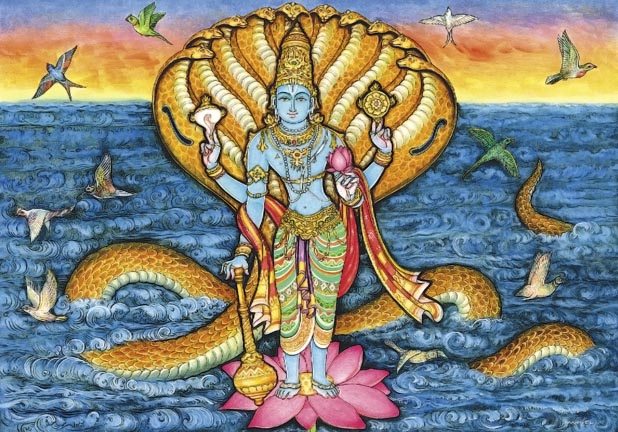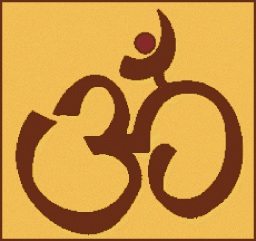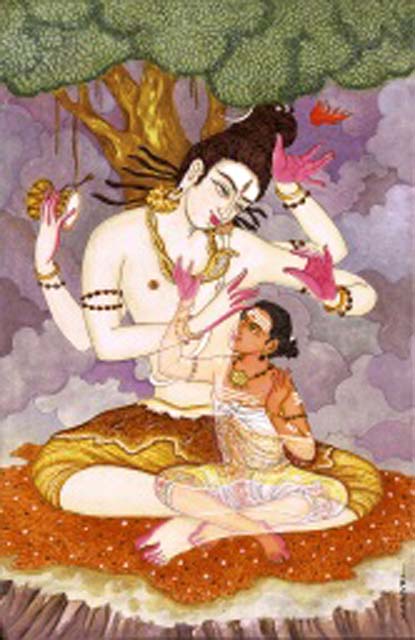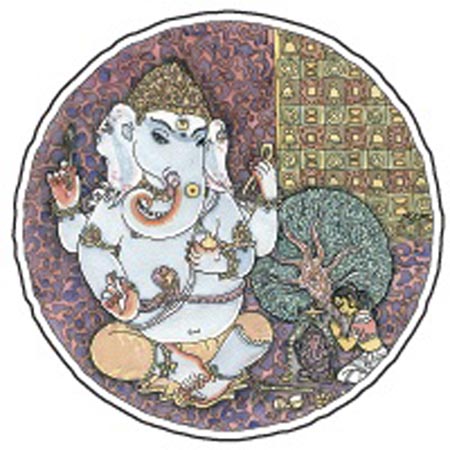
Hinduism 101
Do Hindus eat monkey brains? You would think so if you saw the film ‘Indiana Jones and the Temple of Doom’. Of the western viewers who might have taken this with a pinch of salt as Hollywood excess, many still have the most vexing perceptions about Hinduism from the horrors of caste to the burning of widows. Yes, and don’t forget rat worship, arranged child marriages, female infanticide, dowry and the killing of young brides.
As always, the sensational aspects get magnified, and a deeply complex religion is seen as some sort of a primitive idol-worshiping cult. The many failings of society are laid at religion’s door, as the official manifesto of Hinduism.
So who will set the record straight in the West? After all, here in America, Hinduism is not an organized religion with a huge PR machine and official spokespeople – it is simply a way of life, a philosophy of living practiced by individuals in whichever way they chose, each working toward salvation.
Enter the Interpreters of Dharma, the Myth-Busters.
They are ordinary people: students, housewives, physicians, retirees, academics and engineers. They could be you and me, often asked by curious Westerners about the faith. Some have studied Hinduism in-depth, others have learned the faith simply by living it. They speak to non-Hindus in schools, churches, colleges and social settings and answer the never-ending questions.
“Naturally, I tend to get what I call ‘the 3 Ks’ on a regular basis: Kaste, Kows & Karma,” says Fred Stella, an actor and yoga instructor who lives in Grand Rapids, Michigan. He is president of the Interfaith Dialogue Association and has received training in the Self Realization Fellowship and the local Vedanta Society ashram.
Stella, who started attending a Hindu temple when he was 15, was still being educated in the Catholic school system, and so “developed the ability to speak about Hinduism to those with a Christian mind set.”
He adds, “The other misconceptions are that Hindus don’t acknowledge one absolute source of the universe or God, and that karma is fatalism. They also assume that the cruel tradition of caste bigotry is blessed by our scriptures and that we are somehow related to Islam. They even confuse ‘tamasic’ with turmeric!”
Stella points out that the only exposure many church groups have to Hinduism is through missionary films which show images of destitute villages in India and say ‘Well, this is what you get when you practice bad religion.’
Since he’s teaching non-Hindus, he says, “I try in the most non-sectarian way possible to teach students about the spiritual foundations of yoga. I don’t divorce it from its roots. I walk a fine line but it’s more than just an exercise class.”

Sometimes it is a young Hindu who is challenged to explain the faith to fellow students in college. Ram Sidhaye, a retired marketer living in Atlanta, came to the aid of a medical student who found herself stuck for answers when asked to explain Hinduism. He recalls, “She said, ‘Uncle, what can I say?’ I told her only say three things – that you believe in the law of karma, that you believe in reincarnation and that one of your holy books is the Bhagavad Gita. She felt very good and said, “These things I don’t have to remember – these things I do believe in!”
Sidhaye never learnt Hinduism in a formal way but has read extensively from the Bhagavad Gita and the Upanishads. When his children were young he started a weekly pooja session to give them exposure to the faith. He is often asked to speak at interfaith meetings and always likes to present the unique features of Hinduism through personal anecdotes: “In my own family, my father never went to a temple, my mother would go three times a week – and each one of us has different icons or deities to whom we turn for peace. So Hinduism is all about freedom of thought.”
He is always asked about caste, which can be a hot potato, but rather than be embarrassed or unnerved by it, he tells people openly, “I have nothing to hide. Caste is a curse but it was misused by the Brahmins at one time and these are problems of society that society needs to solve.”
Non-Hindus are very curious about reincarnation, and Sidhaye explains it this way to them: “It’s just like solving a mathematical equation – you assume X, or a variable that you don’t know. If I assume there’s a reason why I was born in a rich family or have all my faculties intact – then the question arises – ‘Why me?’ and there are no logical answers. That’s where karma or the consequences of your actions comes in.”
Beth Kulkarni of Texas came to Hinduism through marriage to a Hindu from India and has become an evocative interpreter of the faith for non-Hindus. She has spoken at church religious classes, religion classes at schools and universities. She also takes non-Hindus on tours of Sri Meenakshi Temple, where she is an Advisory Council member. Kulkarni, who is 62, is a retired technical trainer for a multinational corporation.
“One of the most frequent misconceptions is that Hindus are polytheistic. I reply that we believe in an ‘Ultimate Reality’ that is simultaneously both with form and without form, and that this Ultimate Reality is both transcendent and imminent, both personal and non-personal. I give the example that I, Beth, am a wife, mother, grandmother, friend, community worker, with different functions and relationships due to these various roles, but am still the same ‘Beth.’ How, I ask, could God, therefore, not have different roles, functions, and relationships?”
Kulkarni learnt about Hinduism as much from reading as she did from being part of the Indian-American community. She says, “Nothing can substitute for that community influence.” She finds that while children are very open to new ideas, so are senior citizens, maybe because they have seen enough of life to realize that no one tradition has all the answers.

In this Internet age, sometimes the best way to answer questions is in cyberspace, because you can reach so many more people. M.Menon, 63, who is an industrial design consultant, has been in the U.S. since the 80’s. During his college years he studied all the works of Swami Vivekananda and says, “India, Hinduism and Sanathana Dharma are my passions. I think it is time to spread the word about human Divinity and the universality of the spiritual path. It is much needed in a world that is torn between constrained views of God and humanity.”
He adds, “Most Indians are asked questions about India and Hinduism and very little support is available. Over the past 5 years I have put together an informative Q. & A. online and have also been a participant in Internet discussion groups on Hinduism.”
Menon has also spoken to different church groups, local college study groups and schools, and finds there are many misconceptions about Hinduism, such as Hindus confuse many Gods with one God, are primitive in their belief system, are superstitious and worship animals.
One question he often gets is whether idols are Gods and he replies, “Idols are mere representations of God. They represent various aspects or attributes of a single spiritual reality. Consider for example, the IBM logo representing a company. Logo is not the real company. Icons are essential for focused attention. Much like a logo, the religious icons are full of symbolism.”
Menon, who is working on a book about Hinduism, explains ‘Why so many Gods?’ to non-Hindus as one impersonal Spiritual-Reality that manifests in infinite personal names and forms in the spiritual and material realms: “For Hindus there is no separation between the Creator and that which appears to be created. There is nothing that is outside God. There is no second entity.”
Asked about the Hindu Trinity, he explains it thus to non-Hindus, “Just as pure sunlight is split into a rainbow of colors, Pure Brahman (Absolute Reality, God) is seen through three sided “prism” of time, space and causality as three entities or more. Just as millions of colors can be mixed from the basic three, all of creation is derived from three. Looking from the opposite side, people, their perspectives and their diversity makes One God appear as many. This idea is called Advaitha.”
On the other side of the Atlantic, Jay Lakhani is also doing his share to interpret Hinduism for the Britishers. Originally from Gujarat, born and brought up in Kenya, Lakhani came to the U.K. for further studies at the age of 15. He is a physicist and says, “I took early retirement to focus on what I love best – studying and promoting Hinduism.”
Although he received no formal education in Hinduism, Lakhani has been inspired by the life and teachings of Sri Ramakrishna and Swami Vivekananda. He has become a popular speaker in the London school system, having interacted with over 100 schools from the elite public schools like Harrow to the inner city schools in deprived areas, speaking with young people from all faiths and no faith.
Besides doing a yearly series of talks at the Christian Ministerial College, he is a regular Hindu presenter on the interfaith scene and the main speaker on Hinduism on BBC World Service, with 20 million listeners worldwide.
He has fielded many questions from non-Hindus but he finds that they are most attracted by the idea of the divinity of man: “ When talking to youngsters of the Abrahamic faiths, this idea of the essential nature of everyone as ‘divine’ – equating it to God – grabs them and makes them run after me, asking me excitedly again and again: “Is this really Hinduism?”
To those who want to become Hindus, he says, “You are fine as you are. If you like concepts like ‘divinity of man’ then adopt it, integrate this idea and make it your own. Hinduism does not sell ‘copyrights’ of this concept. It is the inheritance of mankind and belongs to everyone.
This single concept from Swami Vivekananda works like a bombshell. The religious education teachers, the students and the school staff become transformed, they are now in love with Hinduism! Any Non-Hindu exposed to this presentation becomes a lover of Hinduism forever. How can anyone fault this religion that gives highest dignity to mankind?”
He adds that since the vast majority of religious education teachers in the UK are women, the Hindu idea of God as ‘female’ is the most exciting thing they have heard in religious education. He laughs, “Hinduism has stolen their hearts forever! On a serious note, this pluralism of Hindus removes the misconception of Hinduism being polytheist and at the same time gives resolution to the thorny question the world faces.”
Lakhani is also faced often with the C-word, and works hard to demolish the idea of hereditary caste system as being part of Hinduism. He says, “I term this as ‘Atrocity in the name of religion’ and not religion. This is a very important distinction that sometimes gets overlooked in the way Hinduism is presented in the West. This does serious damage to the more important and vibrant aspect of Hinduism promoting ‘Divinity of man’.”
In a small town in rural Pennsylvania, yet another Hindu is sorting out the myths for non-Hindus. Dr. Jeffery D. Long is an Assistant Professor of Religious Studies in Elizabethtown College and did his PhD in comparative religious studies at the University of Chicago, focusing on Hinduism, Buddhism and Jainism. Long has been involved with informal study of Hinduism since his childhood and ultimately embraced it.
Ask him about the questions he encounters from non-Hindus, and he says, “Where to begin!? The most common questions are about karma and rebirth and the mechanism of rebirth. I usually treat this in some detail, making analogies between karma and the laws of physics (such as Newton’s third law of motion), and citing the Gita, emphasizing that the body is the vehicle for the soul’s growth and experience and that our true identity is ultimately not physical but divine.”
Non-Hindus are also curious about caste, especially untouchability. He says, “I always try to problematize caste, explaining that the original Vedic ideal was not of birth-caste, but that birth-caste became the norm at a later period, and that the notion of birth-caste has been contested throughout the history of Hinduism. In the classroom, I generally treat this in historical fashion, citing various reform movements that have occurred throughout the centuries – from the Buddha to Mahatma Gandhi.”
He adds, “ If I am speaking as a Hindu, to a more informal gathering, I share my own philosophy, which is that of Swami Vivekananda that our oneness in God ought to supersede all other factors in our treatment of other beings. I cite the Gita in this regard as well – in fact, I cite the Gita a lot!”
The most common misconception of Hinduism that he has encountered has to do with cows and Gods: “There is a commonly held view that if people in India ate their cows, their hunger problem would vanish. This is, of course, absurd.”
He explains to these skeptics the symbolic importance of the cow in Hinduism, as well as the fact that respect for the cow is really emblematic of respect for all life. As for the perception that Hindus are idol-worshippers, Long explains the symbolism involved in murtipuja and the respects in which the many Gods are simultaneously One God.
“Since my audience is usually Christian, I typically make an analogy with the Christian ideal of the trinity, saying something like, ‘Imagine the trinity extended to an infinity, and you get the basic concept of God in Hinduism’”, he says. “ I also distinguish between the high Gods – Vishnu/Shiva/Shakti conceived as supreme manifestations of Saguna Brahman – and the many other devtas, which are liberated or advanced souls, which I compare to angels and saints when I speak with Christian groups.”
Whether it’s idol worship, cow/monkey/rat worship, bride burning or female infanticide, Dr. Sudhir Prabhu has two secret weapons to combat such questions: “Although my answers are anchored in the scriptures, I always use logic and humor to convey the points to the audience. The responses are almost always well received.”
Prabhu, who has been teaching to varied audiences in churches, interfaith groups and youth study groups for over 20 years, has not had formal training but was, as he likes to say, ‘trained on the job.’ A physician specializing in allergies and asthma, he has served as the chair of the board of the local Hindu temple and on the boards of organizations such as the Red Cross American Lung Association.
He says, “ Since I make frequent presentations in my field, I have taken some public speaking courses, studied the ways of effective communicators and applied these to my presentations. This background has helped me relate to the Western mind and audiences with ease.”

Satish Kapoor conducts ‘Buddhism, Hinduism and Monotheism’, a voluntary course for adults at Burlington County College since several years: ” Needless to say, I get all sorts of questions based on pre-disposed prejudices – caste, cows, poverty, sati and many Hindu gods. To this day, I never had any problem in encountering these questions.”
He recommends that more Hindus volunteer and conduct classes but suggests they read and study the history of Monotheistic religions and their concepts because Hindus who opt to study Christianity and Islam would become better Hindus, gaining comparative appreciation.
Indeed, knowledge of different religions becomes imperative in talking about Hinduism to non-Hindus. Michael W. Smith of St. Francis, Minnesota, has been teaching high schoolers, college students and adults about Hinduism for 30 years. Smith, who acquired knowledge through reading and from his gurus, says: “Christians generally think of Hinduism in terms of idol-worship, a belief in false-gods rather than a single God, cults, devil worship, primitive superstitions and the abuses of the caste system and ill-treatment of women. They do not realize the profundity and sophistication of Hinduism at its best due to their own ignorance, fears, and intolerance.”
Drawing on parallel scriptural readings and certain metaphysical principles, he shows his audiences the transcendent unity of all the world’s spiritual paths: “ There are well-known analogies of there being different paths up the Holy Mountain, and there being a single Holy Well from which various prophets and sages have drunk from, each from their own container.
With Christians, I like to use Plato’s Cave Parable as a starting point, one the most famous parables East or West, and from there, show how both Eastern and Western religions related to it, and then to each other.”
Ved Prakash Chaudhary, PhD, is president of the Hindu International Council Against Defamation, which is dedicated to removing prejudice against Indic traditions. He has been a speaker at many interfaith events in New Jersey, as a Hindu representative many universities including Rutgers and at various churches. He is also on the board of the Monmouth Center for World Religions and Ethical Thought.
Chaudhary, who hails from the district Itawa, a very small town nestled between Agra and Kanpur, came to the U.S. in 1965 as a graduate student at Rutgers University. He’s worked as an engineer with Bell Labs and its subsidiaries until he retired last year. Back in 1987, when the horrific Dot-Buster incidents took place, he found that Indians were not involved in any civic or political institutions, and so were powerless against racist attacks. He was one of the initial group that started the Indian American Forum for Political Education and also pushed for the Hate Crime Bill.
“Our religion is like a closet religion,” says Chaudhary. “Indians are everywhere in hospitals, universities – they are doctors, lawyers, accountants. Americans say they know a lot of Indian people but ask them if they know any Hindus, and they say no. This is because we don’t identify ourselves as Hindus – we only identify ourselves as Indians.”
The result is that many interfaith dialogues, while they have Muslim, Buddhist and Sikh participation, have no Hindu representation and Chaudhary has made it his mission to correct that by offering his services. He says, “We have to be assertive and somebody has to take time and interest. Otherwise, we can complain but we’ll be ignored and we’ll not become part of the community as Hindu-Americans. And the same thing will be true with our children, growing up here.”
Chaudhary got his training in Hinduism from his father, a teacher, who made sure his son knew all about the faith. He laughs, “My name is Ved, after all!” He has participated in interfaith activities in churches, schools and colleges. As another part of his effort to educate non-Hindus, he started the Hindu International Council Against Defamation, on the lines of the Jewish anti-defamation league, to take action against any misinformation or defamation of Hindu gods and rituals. HICAD keeps a vigilant eye on how Hinduism is portrayed in the mainstream and takes offending organizations to task.
There is a lot of misinformation out there about Hinduism, he says, and it starts right in school. Sixth graders have a course called World Cultures and the negative knowledge about Hinduism is in some of these books. “If there are ten pages about Hinduism, several pages may be devoted to the caste system, as if that is the defining characteristic of Hinduism. It is very hard to fight this situation; in New Jersey alone there are 600 school districts – I would have to go to each one to convince them to use or not use certain books.”
After the Global Dharma Conference in New Jersey, Chaudhary along with other participants helped initiate an organization which would be able to correct these problems, Educators’ Society for the Heritage of India (ESHI) – where various professors can get together and network about an accurate presentation of Hinduism to the mainstream.
Coming from very different walks of life, all these people have devoted considerable time and energy to explaining the finer points of Hinduism, combating the misconceptions. What satisfaction do they get from being the Interpreters of Dharma? Says Lakhani, “ It is not a matter of looking for satisfaction. The truth of the matter is I have no choice but to carry on like this. If a little bit of Vivekananda gets into one’s bloodstream – one has no choice in such matters!”
He believes that many Hindus living abroad are adopting the worst of both the East and the West: “This cocktail has produced a very grotesque scenario for modern India and for Hindus everywhere. Concepts like brahmacharya, or respecting and looking after the elderly are considered old fashioned and abandoned. While promiscuous life styles and chasing after mammon are considered to be cool.
It is only when the West recognizes the true value of Hinduism, incorporating ideas of Divinity of Man and the role of religious pluralism, that the Hindus themselves will come to their senses about what valuable treasures they possess.” In this regard, he emphasizes the importance of presenting Hinduism with clarity in the west and says that the work of deciphering Hinduism for non-Hindus is of paramount importance.
Stella, who lives in an area of Michigan that is made up of strong Protestant conservatives, finds satisfaction in doing just that. In the schools where he teaches, 99 percent of the children are from conservative Christian homes, many of whom may never have encountered a real live Hindu.
“Knowing all the misinformation these people are going to come across in their lives, I feel content that I may be the one source who will put it in a different perspective for them,” says Stella. “So perhaps when these people meet their next Hindu, whether it’s at work, or someone who moves on to their block or whether they’re in the same social organization – they will meet that Hindu with less prejudice than if they did not attend one of my talks.”
For Sidhaye, the satisfaction comes from knowing that he has made a sincere and honest effort to answer all the questions that are thrown at him, and that he is able to tell non-Hindus to be objective and not to have a predetermined mindset.
What gives him the most excitement is conveying the fact that Hinduism is the only religion that does not go out to convert people: “Because we believe each individual has the freedom of thought to achieve salvation – I use the word ‘salvation’ because non-Hindus are familiar with it. In fact, I tell them that you will not even find a process for somebody to become a Hindu; I ask them to show me any place where Hindus have gone and done mass conversions. I make ‘freedom of thought’ as the basis of my presentations.”
For someone who remembers the Dotbuster attacks, Chaudhary has been vigilant in passing on the religion to the Hindu children born here, through Sunday classes at the temple, so that they are well armed with knowledge and able to confront questions from their American friends.
“I find the view of Hinduism in the west is very distorted.” he says, “ When people are properly informed, they see Hinduism very differently – so when I feel I’ve been able to shed some light on Hinduism and others can see it as we see it, it gives me great satisfaction.”
Kulkarni, who has become a part of the Indian-American community and has raised her two children in that environment, finds it even more imperative to change the perceptions people may have of Hinduism. She says, “So many Americans know very little about Hindu traditions and I tell them ‘It’s not like 40 or 50 years ago when Hinduism was the religion of people on the other side of the globe – today they are your doctors, they are the motel owners down the street, they are your neighbors.’”
She adds, “Hindus are part of the community and we have to know something about the traditions of each other. It’s extremely satisfying when I explain reincarnation or karma, and non-Hindus realize that they are not such strange notions after all because they do make sense.”
(C) Lavina Melwani


3 Comments
Loka Samasta Sukhino Bhavantu (May happiness be unto the world)
This is a Sanskrit sloka which means all creatures in this universe be happy. We Indians never pray that all Indians live happy – we pray all the creatures in this world live happily
I am Subash, an Indian. Thanks for the good article posted.
Nowadays it’s very difficult to explain Hinduism to those who ask questions. I would like to share some of my views here.
People ask why do Hindu Gods have so many hands and heads? In a picture this is how we show people who have extraordinary powers, who can think multiple things at a time. The only way to express it in a picture is by multiple heads. This is so simple, we can guess the same in the case with multiple hands also.
People also think the Hindu culture is full of superstitions but in Hinduism you can believe the reality you see and feel. In ancient ages, it was a challenge for teachers to teach science to ordinary people, so they taught them through stories as a way for better and clearer understanding.
One example is the lunar eclipse – The passage of all or part of one celestial body into the shadow of another. They explained it this way: Dhanavantri, the Heavenly Physician, emerged with a pot containing nectar. As the Asuras (demons) rushed to take the nectar, the frightened Devas (Gods or demi-gods) appealed to Vishnu, who then turned himself into a maiden named Mohini. The damsel distracted the Asuras, while the Devas secretly drank the nectar. One Asura suspected foul play, disguised himself as a Deva, and drank some nectar. But before the nectar could pass his throat, Vishnu cut off his head. The head, however, remained immortal. It is believed that this immortal head occasionally swallows the sun or the moon, causing eclipses. Then, the sun or moon passes through the opening at the neck, ending the eclipse.
There is a science behind every superstition
Hi Nivi – thanks for your comments. ‘Sita Sings the Blues’ is a critically acclaimed movie and has its own take on Sita’s story. Perhaps we can ask Nina Paley, who is very much a part of NY circles, to explain her thinking and interpretation. Actually, many people hold different opinions about Rama. I recall the noted feminist Madhu Kishwar didn’t have kind things to say about him and her opinion appeared in Hinduism Today.
I agree with you though -‘Rama is not just a mediocre man who left Sita – Hindus are never so simple.’ Forget Gods, I think even we humans are complex, conflicted beings – never simple!
Excellent article, Lavina. When I watched Nina Paley’s ‘Sita Sings the Blues’ this is what I was annoyed about – the interpretation of the myths and characters. Even our own Indian monkeys didn’t know the values of Hinduism and how these characters exalted them! Rama is not just a mediocre man who left Sita – Hindus are never so simple …:)